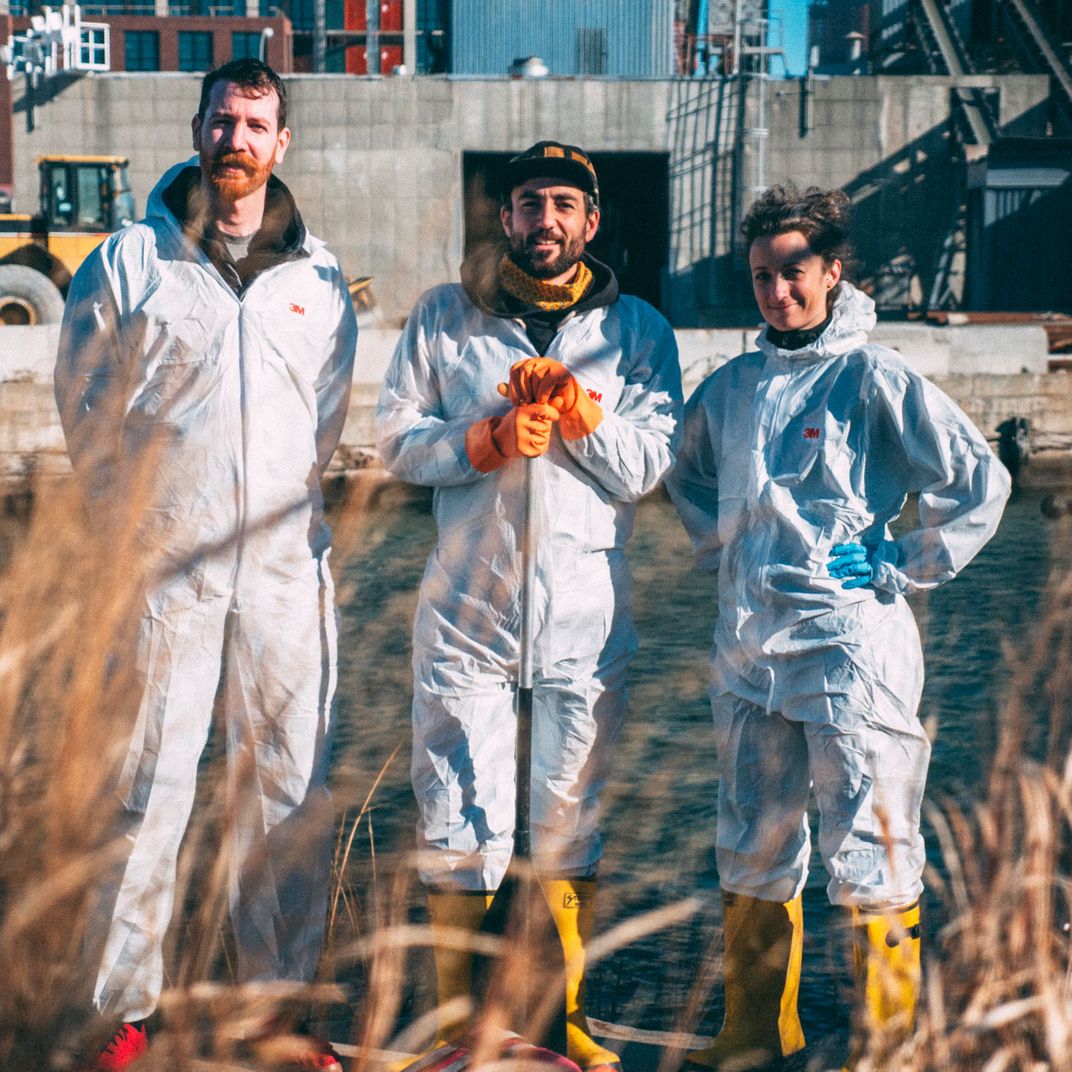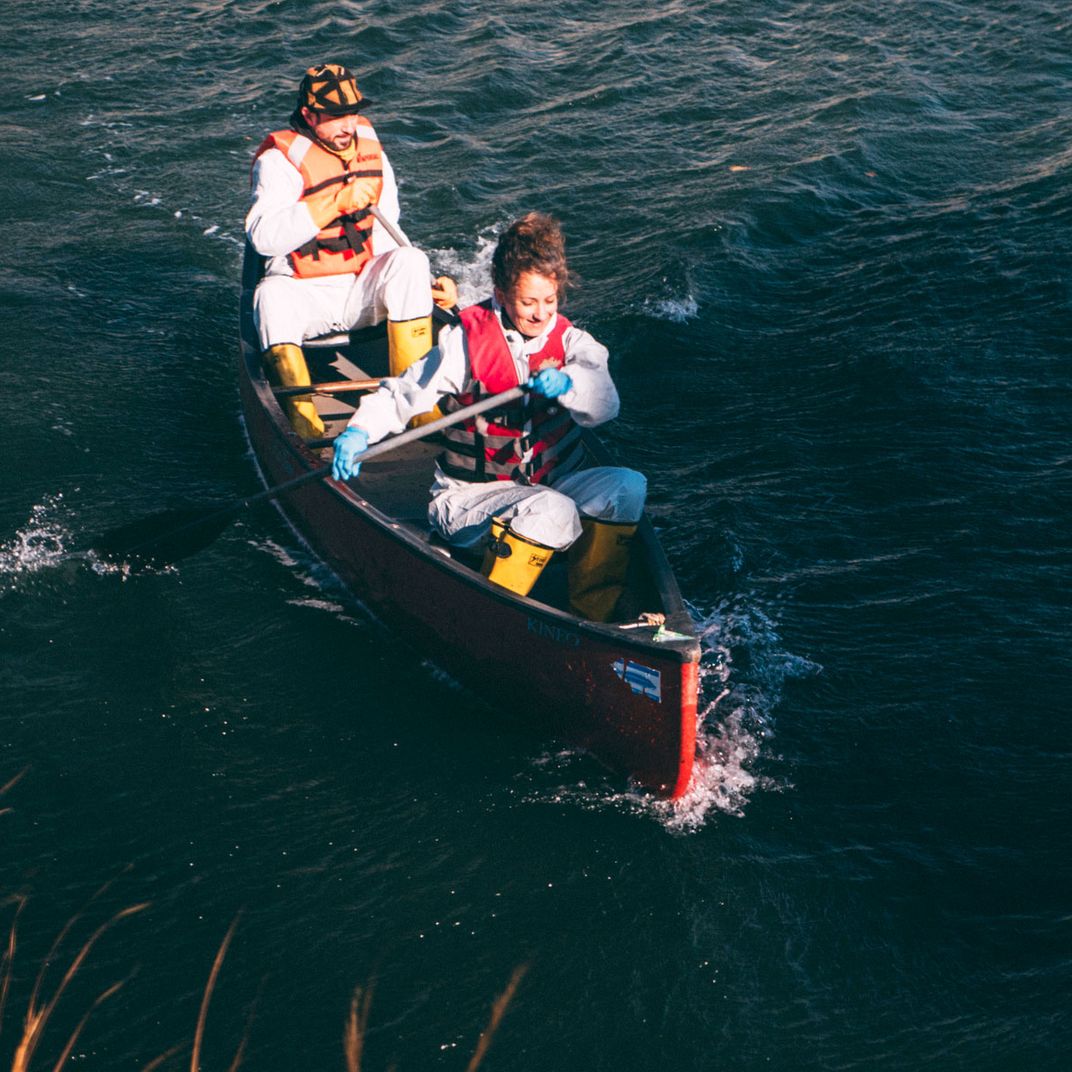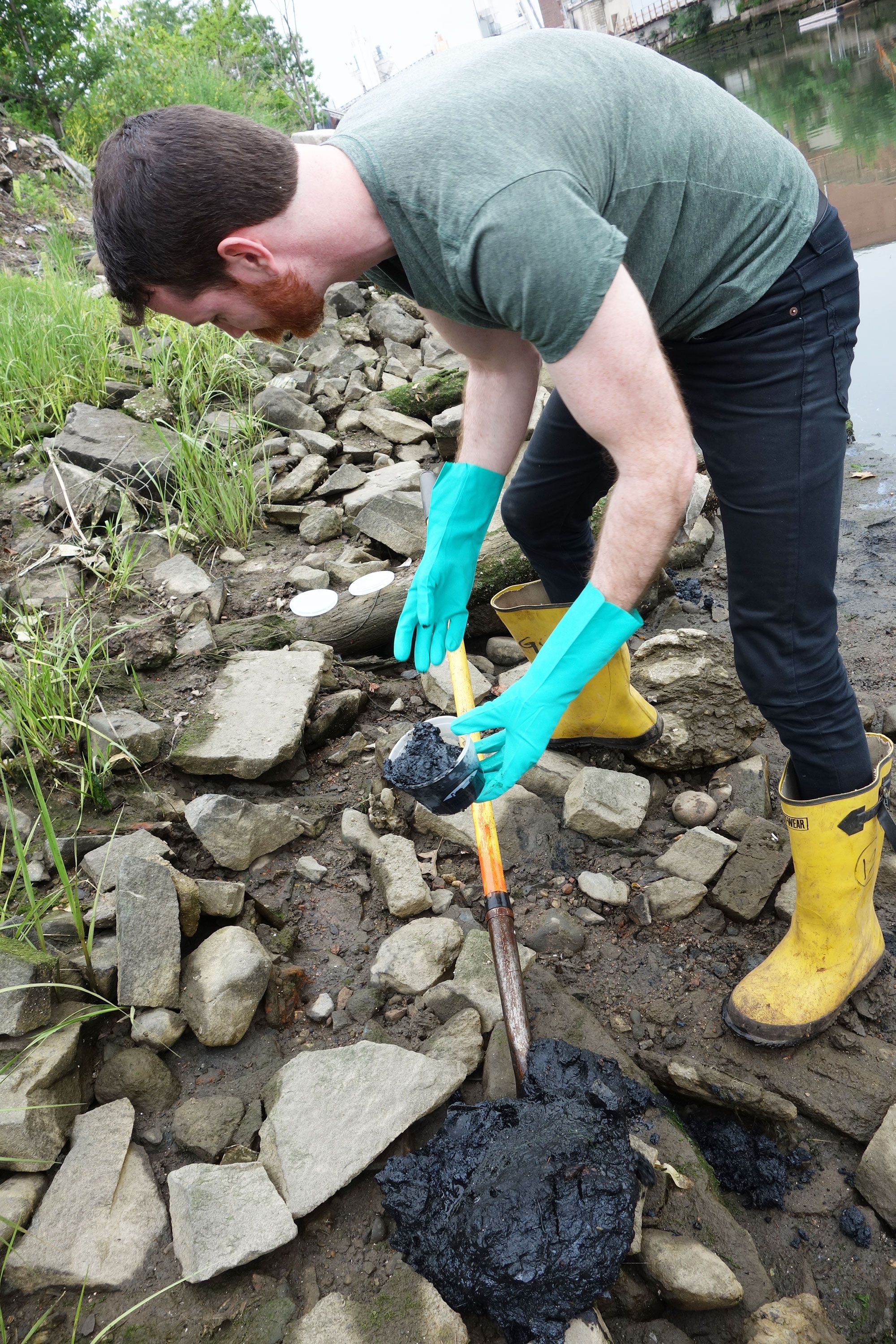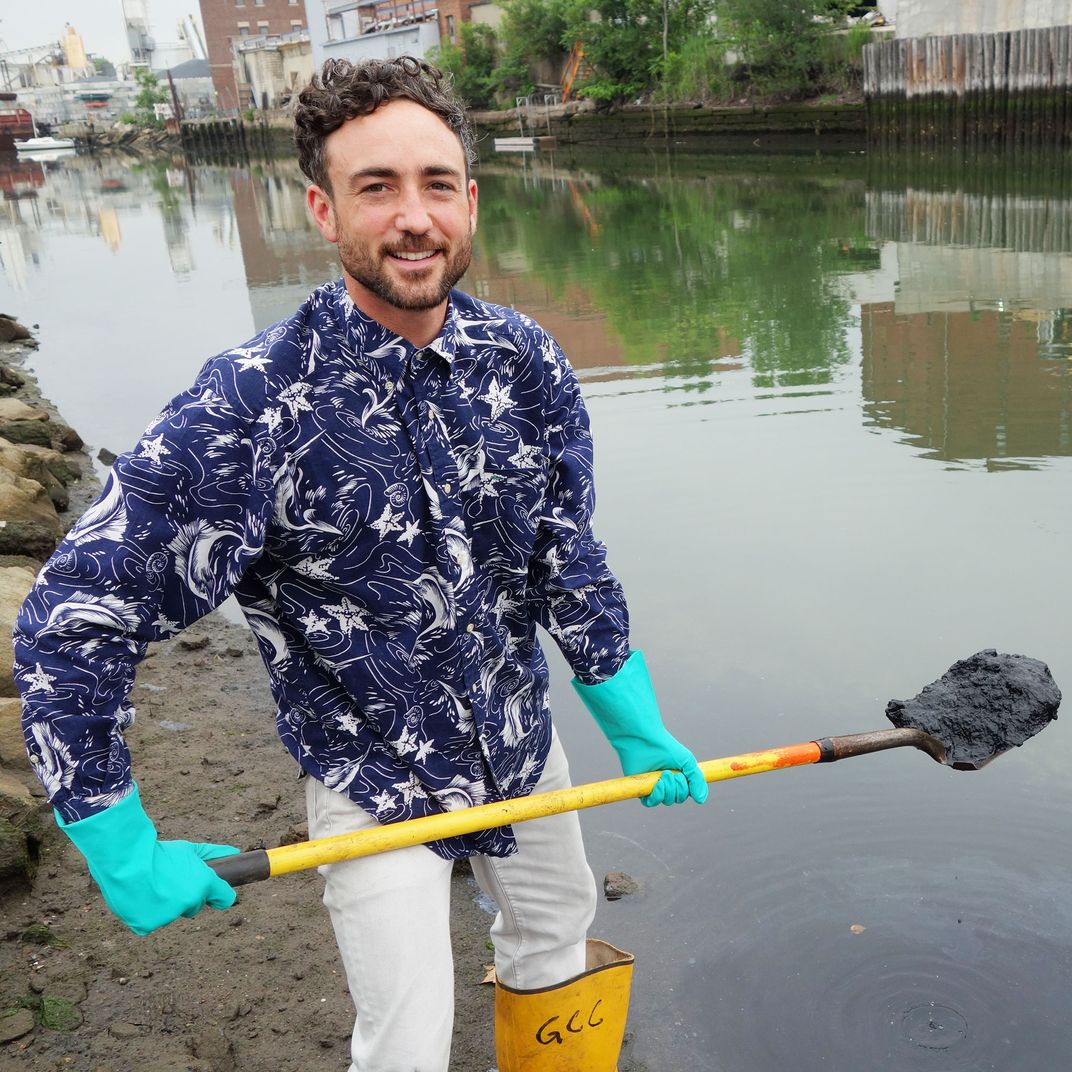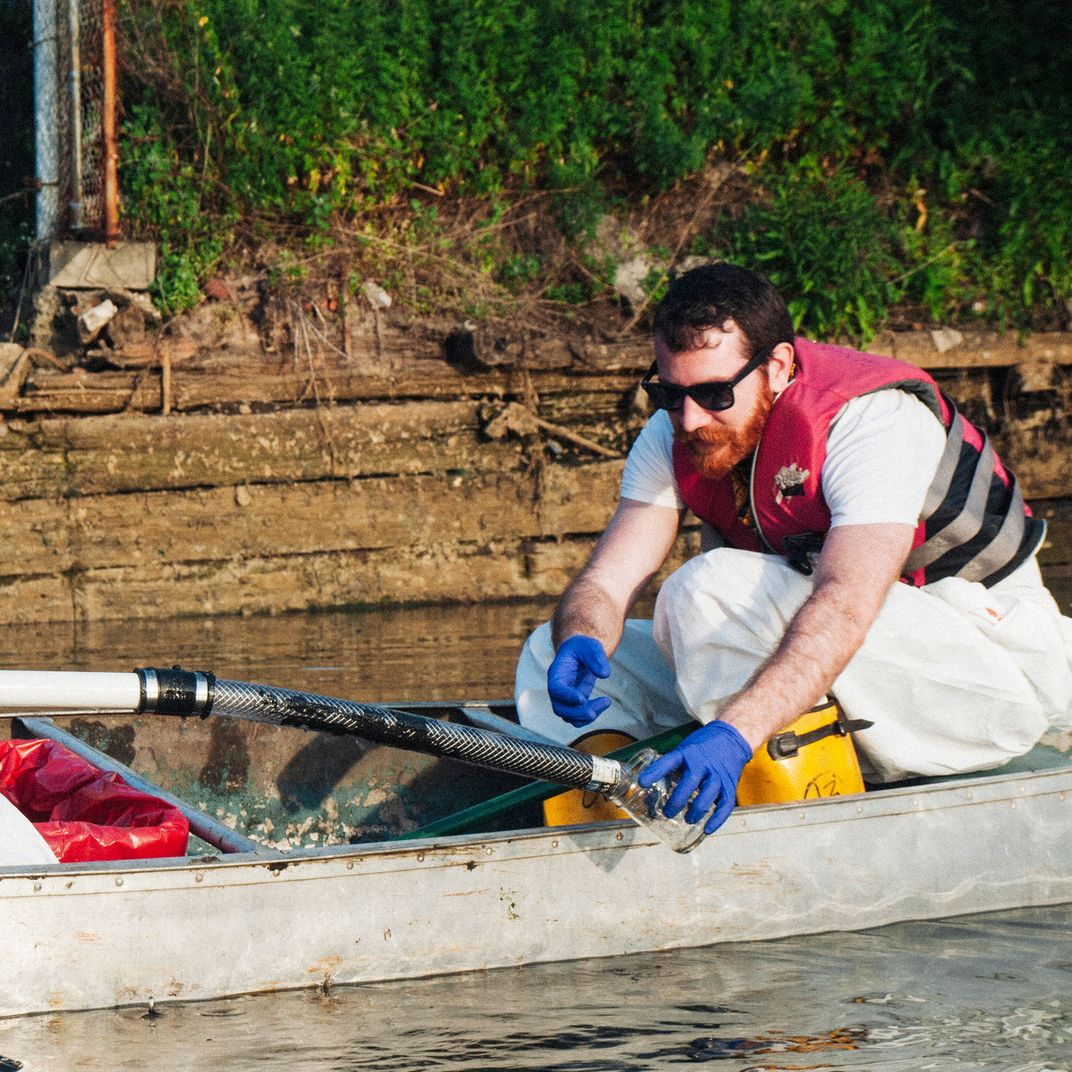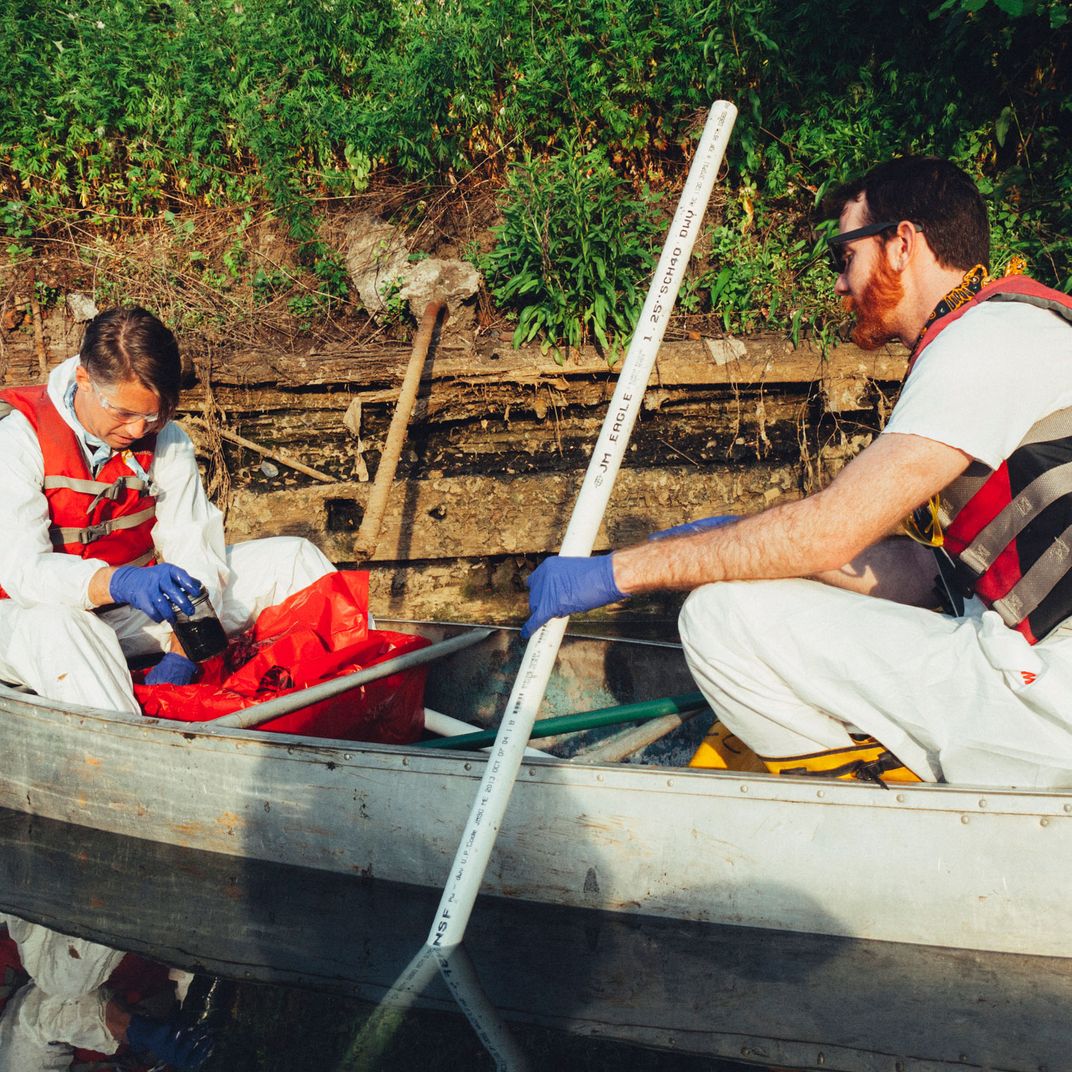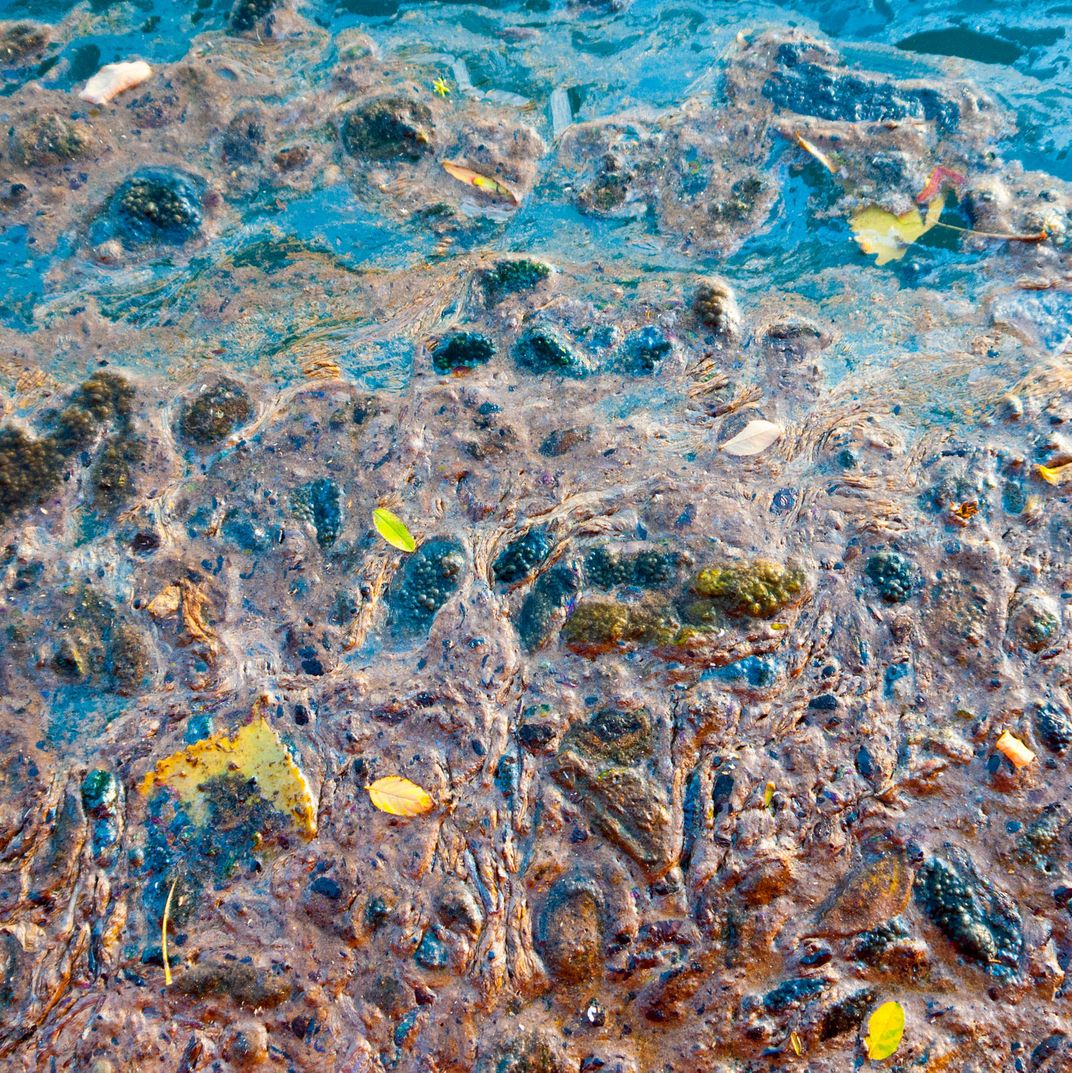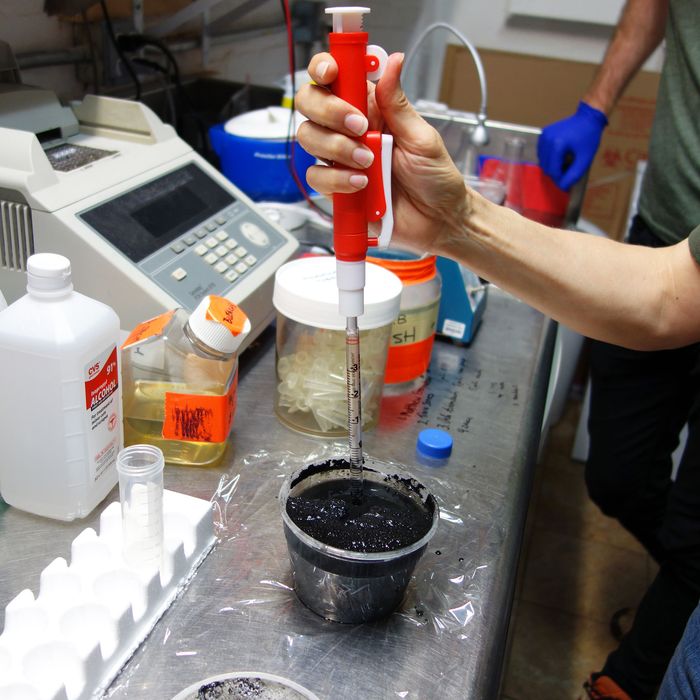
The Gowanus Canal is known as a place where things go to die. In 2007, a malnourished baby minke whale wandered into the canal and swam in its oily sediment (earning the nickname “Sludgie” in the process) and died two days later. In 2013, an injured dolphin lost its way in the canal and didn’t survive the night. A number of small boats have met their ends, too. It’s a notoriously inhospitable place, due in part to the industry that once made the canal a vital commercial shipping hub. For a century, coal-processing plants, and industry that included tanneries, flour mills, and concrete works operated along the 1.8-mile waterway in Brooklyn and dumped their industrial waste into the stagnant water. The factories shut down in the 1960s, but the contamination continued: For the past decades, after heavy rains, stormwater has surged into a sewer system that wasn’t built to withstand the volume of sanitary waste; the raw sewage overflows and ends up in the Gowanus, too. Today, reflective fragments of coal tar cling to the water’s surface, striated in bands like a marble countertop. But most of the toxic stuff lies underneath, in the ten to 15 feet of sediment known as “black mayonnaise”: a mixture of carcinogenic PCBs, pesticides, and heavy metals like lead and mercury.
The toxic sludge is also replete with life, though invisible to the naked eye. Since 2014, Elizabeth Hénaff, a computational biologist at the NYU Tandon School of Engineering, has been studying the universe at the bottom of the Gowanus Canal. What she, along with a team of six scientists and landscape architects, discovered is a community of extremophiles: a class of microorganisms that can survive extreme conditions, whether that be related to temperature, acidity, or chemical concentration. And these extremophiles, Hénaff and her colleagues found, aren’t simply surviving in the hazardous liquid — rather, they’ve developed a miraculous ability to break down the canal’s noxious substances into its less toxic components.
These extremophiles didn’t emerge from nothing. “We’re not recreating the Big Bang in the Gowanus Canal and having life emerge from the primordial soup all over again,” said Hénaff. What we’re witnessing is adaptation. Whereas humans have a generation time of, say, 20 years, microbes have a generation time of something closer to 20 minutes. “So in the time that we’re talking now,” said Hénaff, snapping her fingers, “there will have been three generations of microbes.” The microorganisms are descendants of earlier ones that, after being exposed to the canal’s compounds for more than a hundred years, evolved the ability to degrade its most toxic components: toluene, used in industrial solvents; cresol, a petrochemical byproduct; and atrazine, an industrial herbicide that has been shown to turn male frogs into female ones.
In 2010, the Environmental Protection Agency had named the canal a federal Superfund site, a designation given to the most contaminated locations in the country. But it wasn’t until 2020, close to 263,000 generations of microbes and nearly a decade later, that small barges began dredging the black mayonnaise and shuttling the sediment into bigger barges. Next, the bottom of the canal will be capped with layers of clay, gravel and sand. The cleanup, estimated to be in excess of a billion dollars, coincides with one of the biggest rezoning projects in recent New York history, set to transform the rapidly gentrifying Gowanus neighborhood of Brooklyn into a hub of residential high-rises and retail shops. (Months after the cleanup started, one of the barges sprang a leak and started to sink, delivering some of the dredged waste right back into the Gowanus Bay.)
There’s no question that the canal’s contaminants pose a risk to those who reside along its shores; prolonged exposure to the canal’s water and sludge carries the risk of cancer and of ingesting viruses and parasites. When Hurricane Sandy made landfall in 2012, and the canal flooded, residents of the Gowanus neighborhood found their homes filling with the same polluted water they’d been long advised to avoid. Even the lionhearted have their limits when it comes to the Gowanus, like Gary Francis, a member of the Gowanus Dredgers Canoe Club, a group of canoe-enthusiasts who have advocated for the care of the canal since 1999. Long before the pandemic, the Dredgers would bump elbows in lieu of handshaking and keep sanitizer on deck. (There are times when even Francis will avoid paddling in the water, “like after a heavy rainstorm when all the Combined Sewer Overflows have been flowing,” he said. “It’s disgusting. You see everything.”)
But when the EPA finally cleans up these toxic compounds, the record of life that persisted at the bottom of the canal will also be erased — and with it, a form of cooperation among microorganisms that couldn’t be engineered in a lab. By studying the Gowanus sludge and the life that flourishes in it, Hénaff believes we could learn a thing or two about surviving in a polluted environment. We might even be able to harness their ability to clean up our messes.
From left: Matthew Seibert, Ian Quate, and Elizabeth Hénaff at the Gowanus Canal in 2015.
Elizabeth Hénaff and Ian Quate in a canoe on the Gowanus Canal during a trip to collect samples in 2015.
Matthew Seibert at the very first sampling at the Gowanus Canal in June 2014.
Ian Quate at the Gowanus Canal in June 2014.
From left: Matthew Seibert, Ian Quate, and Elizabeth Hénaff at the Gowanus Canal in 2015.
Elizabeth Hénaff and Ian Quate in a canoe on the Gowanus Canal during a trip to collect samples in 2015.
Matthew Seibert at the very first sampling at the Gowanus Canal in June 2014.
Ian Quate at the Gowanus Canal in June 2014.
The idea to study the bottom of the Gowanus Canal began with Ian Quate, who developed an interest in Superfund sites as a graduate student of landscape architecture at RISD. In 2010 and 2011, he conducted his thesis project at the Berkeley Pit, an open-pit copper mine in Butte, Montana. After the mine shut down in 1982, it began to fill with groundwater, filtered through the old mine shafts and tunnels. Sulfide minerals oxidized in the water, turning it as acidic as lemon juice, corrosive enough to dissolve metal. Animals who find their way to the water seldom make it out alive. In two recorded incidents over the past few decades, flocks of migrating geese made crash landings on the Berkeley Pit during storms. The first time, more than 300 died; the next time, the death toll was in the thousands.
That’s the thing about extreme environments like the Berkeley Pit and the Gowanus Canal: Few organisms can survive them. And given a microbe’s ability to adapt quickly, the ones that do survive the toxicity have likely acquired some unique advantages. That’s what draws scientists to such places: Sure, you could take a submarine to investigate deep-sea hydrothermal vents, where there’s no oxygen and extreme temperatures, or travel to the high-altitude salt flats of the Atacama Desert and study what’s enduring there. Or you could study the organisms in our backyard, in an environment made extreme by human intervention.
While conducting his research, Quate met a pair of research scientists, Andrea and Don Stierle, who had discovered a host of microorganisms living in the Berkeley Pit. From the microbes, they discovered compounds that were able to attack ovarian cancer cells and lung tumors. Inspired by their research, Quate became fixated on the idea that some of the most powerful environmental actors are invisible to the naked eye. Later, he moved to New York and grew fascinated with the Gowanus. While working at Nelson Byrd Woltz, a landscape architect firm, in 2013, Quate pitched a research project on the Gowanus Canal — the EPA had just finalized its plans to dredge the water, but he couldn’t shake the suspicion that there might be something living in it that could offer insight on how to clean it. In 2014, he was introduced to Hénaff.
Like Quate, Hénaff likes to imagine the world on a much smaller scale. While her background is in cancer research, her interest is the environmental microbiome: the communities of microorganisms present in our environment. She is obsessed with how the built environment — the three-dimensional landscape sculpted by architects, city planners, and material scientists — might determine the microscopic lifeforms that can exist there. “My table or the paint on this wall, two materials that seem flat to us, might have vastly different landscapes on a microscopic scale,” she said. She once participated in a study that involved swabbing every subway station in New York City in order to map the subway’s microbiome. But the subway, an open system, does not make for a good controlled experiment. “You have people coming and going, and ventilation systems, and the pizza rat,” she said. So when she heard about Quate’s Gowanus Canal experiment, she didn’t hesitate; it was exactly the kind of closed system that could illustrate how our built environment shapes an environmental microbiome.
In 2014, Quate, with the help of his colleague Matthew Seibert, created a map of the canal and selected 14 sampling locations, each of which corresponded to a different combination of depth, salt concentration, and light. They fashioned a sampling device out of an eight-foot-long piece of PVC, with a four-foot extension for the deeper parts of the canal. To the ends, they affixed a translucent piece of flexible tubing to allow them to see when they’d successfully retrieved some sediment. Wearing Tyvex suits, gloves, and protective goggles, Quate, Seibert, Hénaff, and a team of scientists and architects got on the water in four boats, borrowed from the Gowanus dredgers, with three people in each. Hénaff compared the process of removing the canal sediment to the way a bartender will sample a cocktail by dipping a straw inside the drink and capping it with their finger, creating a vacuum to draw the liquid: The person seated in the back of the boat drove the PVC pipe into the bottom of the canal, capping the top. Lifting the pipe out of the water with the captured bit of sediment, they tilted it toward the person in front, who held onto a specimen tube, trying not to get the sludge on themselves as the person in the back uncapped the pipe. “It’s thick and black and smells like gasoline,” Hénaff said. She also remembered thinking, “There’s no way there’s something living in there.”
Often the muck would get stuck halfway up the tube then rush out all at once, like an explosion. “Oh my God, it was gross,” said Quate. “I mean it’s shit and centuries-old tar byproducts.” When they finished, the researchers had burgers and beers at Lavender Lake, a neighborhood bar whose name pays homage to the canal’s uncanny purple sheen. Then they went home and showered.
The researchers conducted two more sampling expeditions in 2015, and got their sludge samples prepared by a community biotechnology lab called Genspace. Then Hénaff brought the samples back to the lab of Chris Mason at Weill Cornell Medicine, which funded the project’s DNA sequencing. By sequencing its DNA, the team found that microorganisms were not only living in the toxic sludge but also metabolizing it. Hénaff likens this process to the way our bodies metabolize alcohol: “You have a glass of wine at night, and by the morning, that ethanol has been broken down to carbon dioxide and water,” she said. The degradation process takes place through a series of steps called a metabolic pathway, and, rather than having one microorganism handle all the steps, she suspects that it works like a relay, in which different extremophiles of the Gowanus sludge complete a different role before handing off the baton to the next. The microbiome, in other words, functions as a whole, greater than the sum of its parts, which makes it difficult to recreate in a lab.
“You can genetically engineer a microbe to do one thing or maybe a couple of things,” Hénaff said, “but you couldn’t engineer a complex microbiome with a bunch of different species that are living happily together and that are, as a community, responding to a bunch of toxic compounds.” Hénaff’s DNA sequencing also found that the Gowanus microorganisms’ specific metabolic pathways, and the toxic compounds they were degrading in the water, corresponded to historical data of what pollutants the area’s factories were producing. Here the microbes were breaking down cresol from the coal tar; there they were breaking down arsenic, probably from the tanneries. “It’s poetic in a way,” she said. “It’s like the living microbiome of the canal maintains this record of the history of human intervention at this site. The microorganisms are learning to live in capitalist ruins.”
Matthew Seibert and Thomas Woltz extracting samples out of the canal in 2014.
The shore of the Gowanus Canal at low tide in 2014.
Matthew Seibert and Thomas Woltz extracting samples out of the canal in 2014.
The shore of the Gowanus Canal at low tide in 2014.
Microbes have suffered from bad branding. Even before COVID forced us to confront the omnipresence of microorganisms, people have taken pains to eliminate them under the belief that cleanliness is godliness. Hénaff traces this back to the postwar era obsession with developing antibiotics, which became the poster child of modern medicine. An entire industry arose premised on eradicating these invisible so-called bad actors. The pandemic elevated this microbial anxiety to new dimensions.
In recent years, we’ve also begun to understand how human health is inextricably tied to our relationship with microorganisms. At the supermarket today, the labels of everything from salads to ice cream espouse the benefits of promoting healthy gut bacteria; in 2019, the gut-health industrial complex in the United States swelled to a $37.93 billion market. To Hénaff, the environmental microbiome is as significant to our wellbeing as the microbiome inside our bodies. A proponent of what she calls “collaborative survival” (a term coined by feminist theorist and author Anna Tsing), Hénaff imagines a future where we can harness microorganisms’ ability to quickly adapt to their surroundings — especially as climate change introduces more chaos to our environment. Her 100-year vision is to eventually be able to construct probiotic buildings — structures that, through deliberate design decisions, create a robust and diverse microbiome. That could be something as banal as having windows that actually open, she said, or using jute carpeting instead of synthetic. Or it might be something more complex, like building indoor green walls.
In theory, the microorganisms living in the Gowanus Canal could eventually turn the toxic sediment into less toxic sediment. Hénaff’s lab hasn’t measured the speed at which these microorganisms would be able to clean up the canal, though she estimates that it would be on a scale of thousands of years, at least — certainly not fast enough for the developers whose interests lie in capitalizing off the EPA cleanup. While she acknowledges that it’s essential to curtail the exposure of Gowanus residents to these contaminants, Hénaff and Quate make the case for preserving at least some of the canal as is. “Leave an area the size of a refrigerator, so that you could study it,” Quate said.
One afternoon, Hénaff and I stood at the shoreline of the canal, observing schools of small fish in the shallows. We found a bench to sit along the esplanade outside Whole Foods. Beneath the bridge on Third Avenue, we observed a crab-apple tree. Not native to the lowlands, we wonder, how did it get there? “Someone probably threw their apple core there one day and it grew,” Hénaff suggested. If microorganisms can teach us anything, it’s that life is opportunistic. We sat, marveling at three its branches heavy with fruit.


